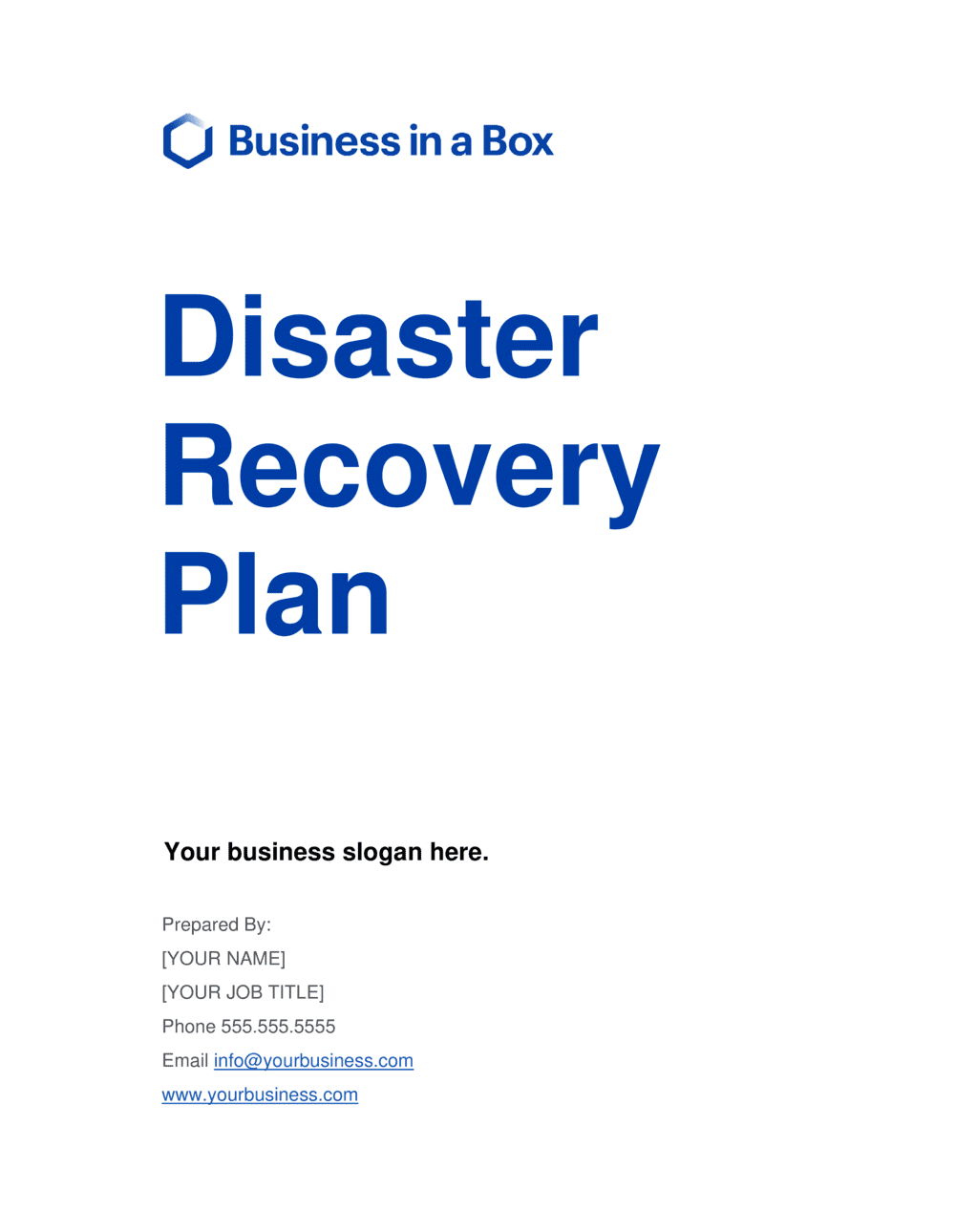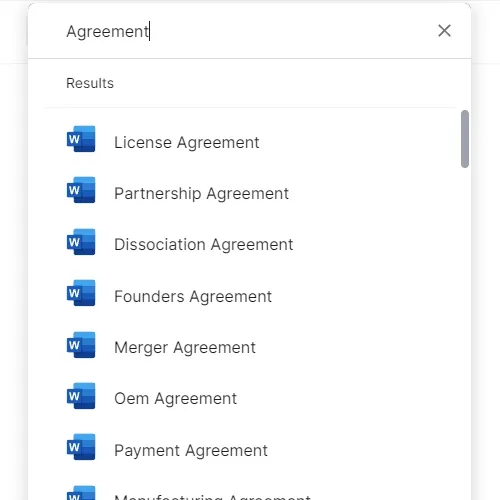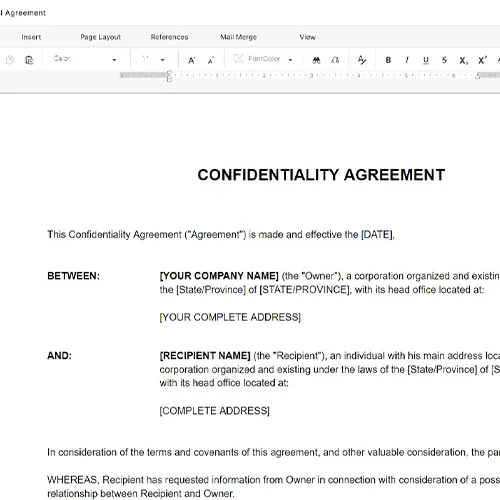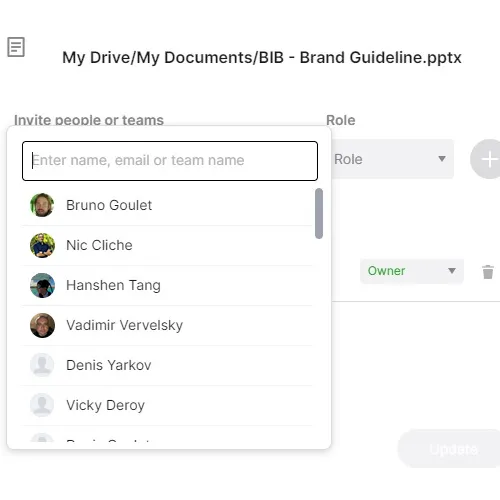Disaster Recovery Plan Template

Understanding a Disaster Recovery Plan
A Disaster Recovery Plan (DRP) is a critical document that outlines strategies and procedures for responding to and recovering from unexpected disruptive events. These events can range from natural disasters to cyber-attacks, and the plan is designed to minimize downtime, protect data, and ensure business continuity. It provides clear guidance for restoring essential systems and operations swiftly and effectively after a disaster.
What is a Disaster Recovery Plan?
A Disaster Recovery Plan template provides a structured framework to systematically outline the key elements of an organization’s disaster response:
- Purpose and Scope - Clearly defines the goals of the plan, including the types of disasters it covers, and the scope of systems and processes it aims to protect.
- Roles and Responsibilities - Identifies key personnel responsible for implementing the plan, along with their specific roles during a disaster recovery.
- Critical Systems and Prioritization - Lists the business-critical systems and processes that need immediate attention in the event of a disaster, along with a prioritization strategy.
- Disaster Response Procedures - Provides step-by-step procedures for responding to various disaster scenarios, ensuring a rapid and effective response.
- Backup and Recovery Procedures - Details the methods and schedules for backing up critical data and the steps required for data restoration.
- Communication Plan - Outlines how to communicate with stakeholders, employees, clients, and external parties during a disaster to ensure accurate and timely information dissemination.
- Testing and Maintenance - Specifies the schedule and procedures for regularly testing and updating the disaster recovery plan to ensure its effectiveness.
- Vendor and Third-Party Coordination - Details how to engage with key vendors and third parties to ensure their support during a disaster.
- Plan Activation and Escalation - Defines the criteria for activating the plan and the escalation procedures for coordinating with senior management and external authorities.
Supporting Documents for Structuring a Disaster Recovery Plan
To enhance the clarity and comprehensiveness of a Disaster Recovery Plan, including related documents is advisable:
- Business Impact Analysis (BIA) - A detailed analysis that identifies critical business functions and the potential impact of their disruption, guiding the prioritization of recovery efforts.
- Incident Response Plan (IRP) - A plan that provides detailed guidelines for handling security incidents and breaches, which often occur alongside disasters.
- Emergency Response Policy - A concise set of guidelines detailing the organization's immediate actions in emergencies, including communication protocols, evacuation procedures, and coordination with emergency services. It ensures prompt and effective measures to protect personnel and assets in a crisis.
Why Use a Comprehensive Disaster Recovery Plan Template?
Using a structured template for drafting a Disaster Recovery Plan offers significant benefits:
- Operational Continuity - Provides a structured approach to restoring critical systems and processes, minimizing downtime.
- Risk Mitigation - Helps identify potential risks and vulnerabilities, enabling proactive mitigation strategies.
- Stakeholder Confidence - Demonstrates a commitment to resilience and preparedness, inspiring confidence among clients, investors, and employees.
- Regulatory Compliance - Ensures adherence to industry regulations and standards, avoiding legal issues and penalties.
Adopting a comprehensive Disaster Recovery Plan is crucial for any organization to ensure it can withstand and recover from disasters. It provides a clear and actionable framework for safeguarding data, systems, and operations, protecting business continuity.
Updated in May 2024
Reviewed on

Understanding a Disaster Recovery Plan
A Disaster Recovery Plan (DRP) is a critical document that outlines strategies and procedures for responding to and recovering from unexpected disruptive events. These events can range from natural disasters to cyber-attacks, and the plan is designed to minimize downtime, protect data, and ensure business continuity. It provides clear guidance for restoring essential systems and operations swiftly and effectively after a disaster.
What is a Disaster Recovery Plan?
A Disaster Recovery Plan template provides a structured framework to systematically outline the key elements of an organization’s disaster response:
- Purpose and Scope - Clearly defines the goals of the plan, including the types of disasters it covers, and the scope of systems and processes it aims to protect.
- Roles and Responsibilities - Identifies key personnel responsible for implementing the plan, along with their specific roles during a disaster recovery.
- Critical Systems and Prioritization - Lists the business-critical systems and processes that need immediate attention in the event of a disaster, along with a prioritization strategy.
- Disaster Response Procedures - Provides step-by-step procedures for responding to various disaster scenarios, ensuring a rapid and effective response.
- Backup and Recovery Procedures - Details the methods and schedules for backing up critical data and the steps required for data restoration.
- Communication Plan - Outlines how to communicate with stakeholders, employees, clients, and external parties during a disaster to ensure accurate and timely information dissemination.
- Testing and Maintenance - Specifies the schedule and procedures for regularly testing and updating the disaster recovery plan to ensure its effectiveness.
- Vendor and Third-Party Coordination - Details how to engage with key vendors and third parties to ensure their support during a disaster.
- Plan Activation and Escalation - Defines the criteria for activating the plan and the escalation procedures for coordinating with senior management and external authorities.
Supporting Documents for Structuring a Disaster Recovery Plan
To enhance the clarity and comprehensiveness of a Disaster Recovery Plan, including related documents is advisable:
- Business Impact Analysis (BIA) - A detailed analysis that identifies critical business functions and the potential impact of their disruption, guiding the prioritization of recovery efforts.
- Incident Response Plan (IRP) - A plan that provides detailed guidelines for handling security incidents and breaches, which often occur alongside disasters.
- Emergency Response Policy - A concise set of guidelines detailing the organization's immediate actions in emergencies, including communication protocols, evacuation procedures, and coordination with emergency services. It ensures prompt and effective measures to protect personnel and assets in a crisis.
Why Use a Comprehensive Disaster Recovery Plan Template?
Using a structured template for drafting a Disaster Recovery Plan offers significant benefits:
- Operational Continuity - Provides a structured approach to restoring critical systems and processes, minimizing downtime.
- Risk Mitigation - Helps identify potential risks and vulnerabilities, enabling proactive mitigation strategies.
- Stakeholder Confidence - Demonstrates a commitment to resilience and preparedness, inspiring confidence among clients, investors, and employees.
- Regulatory Compliance - Ensures adherence to industry regulations and standards, avoiding legal issues and penalties.
Adopting a comprehensive Disaster Recovery Plan is crucial for any organization to ensure it can withstand and recover from disasters. It provides a clear and actionable framework for safeguarding data, systems, and operations, protecting business continuity.
Updated in May 2024
Easily Create Any Business Document You Need in Minutes.

Download or open template
Access over 3,000+ business and legal templates for any business task, project or initiative.

Edit and fill in the blanks
Customize your ready-made business document template and save it in the cloud.

Save, Share, Export, or Sign
Share your files and folders with your team. Create a space of seamless collaboration.


